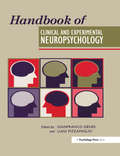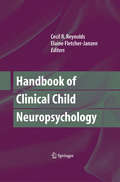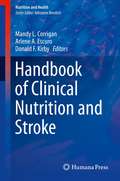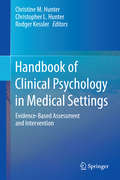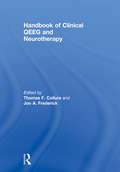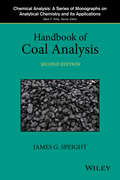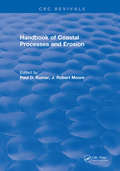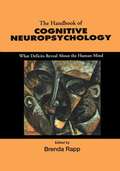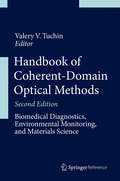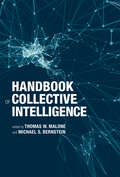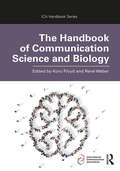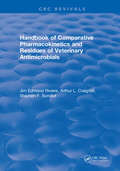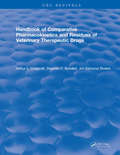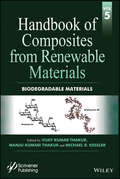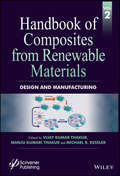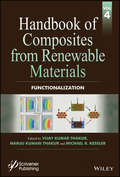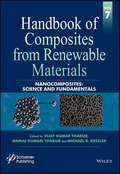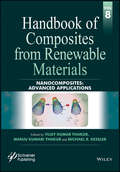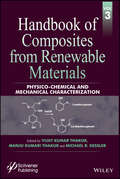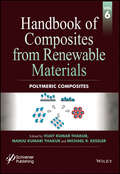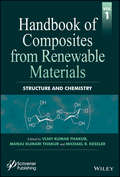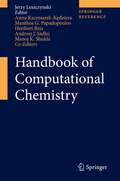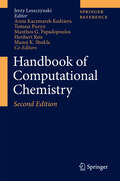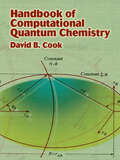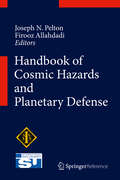- Table View
- List View
Handbook Of Clinical And Experimental Neuropsychology
by Gianfranco Denes Luigi PizzamiglioThe domain of neuroscience has had one of the most explosive growths in recent decades: within this development there has been a remarkable and renewed interest in the study of the relations between behaviour and the central nervous system. Part of this new attention is connected with the contribution of new technologies (PET, fMRI) permitting more precise mapping of neural structures responsible for cognitive functions and the development of new theoretical models of mental activities.The diffusion of new pathologies (for example the pattern of cognitive impairment associated with AIDS) has further enlarged the field of clinical neuropsychology. Finally there has been an expanding clinical interest in the understanding and management of age-related cognitive changes.This volume is the translated and updated version of the second edition of Manuale di Neuropsicologia (Zanichelli, 1996), by the same authors, and it reflects the current status of the art. It is intended to blend clinical and theoretical aspects of neuropsychology. The first part discusses the instrumental and clinical methods of investigation in neuropsychology, together with their development. A long section is dedicated to the language and memory disorders. The impairment of non-verbal cognitve functions, such as the disorders of space orientation, of of visuo-perceptive abilities, and of the emotions and attention, are extensively discussed. The pattern of degenerative dementias is thorougly described, as e is thoroughly described, as well as a number of new topics, such as a neuropsychological approach to consciousness. Finally, perspectives for treatment of some cognitive disorders are outlined.
Handbook of Clinical Child Neuropsychology
by Elaine Fletcher-Janzen Cecil R. ReynoldsEvery chapter has been updated to reflect current thought and research in the field. Chapters devoted to specialized tests in neuropsychology have been updated to reflect new editions of these popular instruments. Special topic chapters have been added such as working in pediatric coma rehabilitation, using the planning, attention, sequential, simultaneous theory of neuropsychological processes, additions on ADHD, and more appear written by the leading experts and practitioners in these fields to reflect the demands of current practice in clinical child neuropsychology.
Handbook of Clinical Nutrition and Stroke
by Arlene A. Escuro Donald F. Kirby Mandy L. CorriganHandbook of Clinical Nutrition and Stroke is a comprehensive reference on nutrition for the multidisciplinary team caring for stroke patients. Targeting physicians, nurse practitioners, clinical dietitians, and advanced allied health and medical students, this volume provides an introduction on the different types of stroke, associated risk factors, and uniquely featured global perspectives on stroke. In addition to discussing stroke risk factors, the book expands upon treatment and management from the acute care setting through rehabilitation, captures the lifespan of patients affected by stroke, and discusses the progression of the nutrition care plan. Containing the most up-to-date, evidence based information currently available, Handbook of Clinical Nutrition and Stroke is a valuable resource for clinicians working with the stroke population.
Handbook of Clinical Psychology in Medical Settings
by Christine M. Hunter Christopher L. Hunter Rodger KesslerGrowing recognition of the role of behavioral health in overall health, the rise of health psychology, the trend toward interdisciplinary medicine--any number of factors have made clinical psychology an integral part of integrative care. Its applicability to the range of specialties, populations, and levels of care adds to its increasing necessity in diverse healthcare settings. The Handbook of Clinical Psychology in Medical Settings emphasizes evidence-based care and practical strategies for hands-on work with patients while illuminating the unique aspects of the practice of psychology within medical settings. Skills are examined in depth for more effective work with patients, more efficient teamwork with colleagues, and better functioning within medical settings, whether readers are involved in primary, secondary, or tertiary care or prevention. Chapters also focus on ethical, legal, and financial issues, as well as changes needed in training programs to ensure that the field keeps up with the evolution of care systems and service delivery. Included in the Handbook 's forward-looking coverage: Psychology and population health. Core competencies for success in medical settings. Evidence-based practice--and practice-based evidence. Marketing health psychology, both within and outside the medical setting. Competency for diverse populations. Plus chapters devoted to specific specialties and settings, from cardiology to women's health. Comprehensive yet highly readable, the Handbook of Clinical Psychology in Medical Settings is a practice-building resource for health psychologists, clinical psychologists, and primary care physicians.
Handbook of Clinical QEEG and Neurotherapy
by Thomas F. Collura Jon A. FrederickThis book is an essential resource describing a wide range of approaches and technologies in the areas of quantitative EEG (QEEG) and neurotherapy including neurofeedback and neuromodulation approaches. It emphasizes practical, clinically useful methods, reported by experienced clinicians who have developed and used these approaches first hand. These chapters describe how the authors approach and use their particular combinations of technology, and how clients are evaluated and treated. This resource, which is encyclopedic in scope, provides a valuable and broad, yet sufficiently detailed account, to help clinicians guide the future directions in client assessment and neurotherapeutic treatment. Each contribution includes literature citations, practical information related to clinical interventions, and clinical outcome information.
Handbook of Coal Analysis
by James G. SpeightProvides users with everything they need to know about testing and analysis of coal Includes new coverage on environmental issues and regulations as related to coal Provides the reader with the necessary information about testing and analyzing coal and relays the advantages and limitations in understanding the quality and performance of coal Explains the meaning of test results and how these results can predict coal behavior and its corresponding environmental impact during use Includes a comprehensive Glossary which defines items in straightforward language that enable readers to better understand the terminology related to coal Treats issues related to sampling, and accuracy and precision of analysis
Handbook of Coastal Processes and Erosion
by Paul D. KomarThe objective of this book is to focus on the physical processes that cause coastal erosion.Many scientists and engineers have focused their research on the entire range of physical processes from the waves and the currents in the nearshore to the response of the beach, via sand transport, resulting in a changing coastal morphology. Of these many processes, this book focuses only on those which directly relate the generation of coastal erosion. Some chapters deal exclusively with the physical processes, while others provide examples of erosion problems although most of the chapter topics have clear implications for issues of coastal-zone management, these issues are not belaboured as several other books are already available in this area. The objective is to provide state-of-the-art presentation of the science of coastal erosion processes.
Handbook of Cognitive Neuropsychology: What Deficits Reveal About the Human Mind
by Brenda RappThis volume reviews the full range of cognitive domains that have benefited from the study of deficits. Chapters covered include language, memory, object recognition, action, attention, consciousness and temporal cognition.
Handbook of Coherent-Domain Optical Methods
by Valery V. TuchinThis Handbook provides comprehensive coverage of laser and coherent-domain methods as applied to biomedicine, environmental monitoring, and materials science. Worldwide leaders in these fields describe the fundamentals of light interaction with random media and present an overview of basic research. The latest results on coherent and polarization properties of light scattered by random media, including tissues and blood, speckles formation in multiple scattering media, and other non-destructive interactions of coherent light with rough surfaces and tissues, allow the reader to understand the principles and applications of coherent diagnostic techniques. The expanded second edition has been thoroughly updated with particular emphasis on novel coherent-domain techniques and their applications in medicine and environmental science. Volume 1 describes state-of-the-art methods of coherent and polarization optical imaging, tomography and spectroscopy; diffusion wave spectroscopy; elastic, quasi-elastic and inelastic light scattering spectroscopy and imaging; digital holographic microscopy, the Fourier transform light scattering method, and coherent diffractive imaging; wavefront sensing, aberration measurement and adaptive optics for ophthalmology; and laser remote sensing. Volume 2 presents the new and growing field of coherent optics in optical coherence tomography (OCT). Various applications of OCT and confocal microscopy, including biomedical endoscopy, are discussed. A special section covers Mueller matrix polarimetry, nonlinear laser fluorescence spectroscopy, and triplet-triplet annihilation assisted upconversion as optical tools for probing the physical parameters of materials and natural organic compounds.
Handbook of Collective Intelligence
by Thomas W. Malone Michael S. BernsteinExperts describe the latest research in a rapidly growing multidisciplinary field, the study of groups of individuals acting collectively in ways that seem intelligent.Intelligence does not arise only in individual brains; it also arises in groups of individuals. This is collective intelligence: groups of individuals acting collectively in ways that seem intelligent. In recent years, a new kind of collective intelligence has emerged: interconnected groups of people and computers, collectively doing intelligent things. Today these groups are engaged in tasks that range from writing software to predicting the results of presidential elections. This volume reports on the latest research in the study of collective intelligence, laying out a shared set of research challenges from a variety of disciplinary and methodological perspectives. Taken together, these essays—by leading researchers from such fields as computer science, biology, economics, and psychology—lay the foundation for a new multidisciplinary field.Each essay describes the work on collective intelligence in a particular discipline—for example, economics and the study of markets; biology and research on emergent behavior in ant colonies; human-computer interaction and artificial intelligence; and cognitive psychology and the “wisdom of crowds” effect. Other areas in social science covered include social psychology, organizational theory, law, and communications.ContributorsEytan Adar, Ishani Aggarwal, Yochai Benkler, Michael S. Bernstein, Jeffrey P. Bigham, Jonathan Bragg, Deborah M. Gordon, Benjamin Mako Hill, Christopher H. Lin, Andrew W. Lo, Thomas W. Malone, Mausam, Brent Miller, Aaron Shaw, Mark Steyvers, Daniel S. Weld, Anita Williams Woolley
The Handbook of Communication Science and Biology (ICA Handbook Series)
by Kory Floyd René WeberThe Handbook of Communication Science and Biology charts the state of the art in the field, describing relevant areas of communication studies where a biological approach has been successfully applied. The book synthesizes theoretical and empirical development in this area thus far and proposes a roadmap for future research. As the biological approach to understanding communication has grown, one challenge has been the separate evolution of research focused on media use and effects and research focused on interpersonal and organizational communication, often with little intellectual conversation between the two areas. The Handbook of Communication Science and Biology is the only book to bridge the gap between media studies and human communication, spurring new work in both areas of focus. With contributions from the field’s foremost scholars around the globe, this unique book serves as a seminal resource for the training of the current and next generation of communication scientists, and will be of particular interest to media and psychology scholars as well.
Handbook of Comparative Pharmacokinetics and Residues of Veterinary Antimicrobials
by Jim E RiviereThe major objective of this handbook is to compile-in tabular form-the pharmacokinetic parameters of antimicrobial drugs used in food animals. This unique publication represents data from the FARAD (Food Animal Residue Avoidance Databank) databank, established by the authors under the auspices of the U.S.D.A. and contains significant amounts of previously unavailable information. This updated, one-of-a-kind volume even features additional data on laboratory rodents, dogs, cats, and horses in order to facilitate broader interspecies extrapolations. This easy-to-use reference is timely as well as invaluable to animal scientists, veterinarians, pharmacologists, and toxicologists who work with antimicrobials in chickens, turkeys, dairy and beef cattle, swine, goats, and sheep.
Handbook of Comparative Pharmacokinetics and Residues of Veterinary Therapeutic Drugs
by Arthur L. CraigmillHandbook of Comparative Pharmacokinetics and Residues of Veterinary Therapeutic Drugs is a unique compilation of comparative pharmacokinetic data for veterinary therapeutic drugs. The book features an excellent introductory chapter on basic veterinary pharmacokinetics and includes pharmacological data taken from hundreds of primary research references. These data are presented in standardized units and are arranged in conveniently organized tables so that comparisons between data can be made easily. Much of the data is new and was taken from articles in which data was not subjected to pharmacokinetic analysis.
Handbook of Composites from Renewable Materials, Biodegradable Materials
by Manju Kumari Thakur Michael R. Kessler Vijay Kumar ThakurThe Handbook of Composites From Renewable Materials comprises a set of 8 individual volumes that brings an interdisciplinary perspective to accomplish a more detailed understanding of the interplay between the synthesis, structure, characterization, processing, applications and performance of these advanced materials. The handbook covers a multitude of natural polymers/ reinforcement/ fillers and biodegradable materials. Together, the 8 volumes total at least 5000 pages and offers a unique publication. This 5th volume Handbook is solely focused on Biodegradable Materials. Some of the important topics include but not limited to: Rice husk and its composites; biodegradable composites based on thermoplastic starch and talc nanoparticles; recent progress in biocomposites of biodegradable polymer; microbial polyesters: production and market; biodegradable and bio absorbable materials for osteosynthesis applications; biodegradable polymers in tissue engineering; composites based on hydroxyapatite and biodegradable polylactide; biodegradable composites; development of membranes from bio-based materials and their applications; green biodegradable composites based on natural fibers; fully biodegradable all-cellulose composites; natural fiber composites with bio-derivative and/or degradable polymers; synthetic biodegradable polymers for bone tissue engineering; polysaccharides as green biodegradable platforms for building-up electroactive composite materials; biodegradable polymer blends and composites from seaweeds; biocomposites scaffolds derived from renewable resources for bone tissue repair ; pectin-based composites; recent advances in conductive composites based on biodegradable polymers for regenerative medicine applications; biosynthesis of PHAs and their biomedical applications; biodegradable soy protein isolate/poly (vinyl alcohol) packaging films and biodegradability of bio-based polymeric materials in natural environment.
Handbook of Composites from Renewable Materials, Design and Manufacturing
by Manju Kumari Thakur Michael R. Kessler Vijay Kumar ThakurThe Handbook of Composites From Renewable Materials comprises a set of 8 individual volumes that brings an interdisciplinary perspective to accomplish a more detailed understanding of the interplay between the synthesis, structure, characterization, processing, applications and performance of these advanced materials. The handbook covers a multitude of natural polymers/ reinforcement/ fillers and biodegradable materials. Together, the 8 volumes total at least 5000 pages and offers a unique publication. This 2nd volume of the Handbook is solely focused on the Design and Manufacturing of renewable materials. Some of the important topics include but not limited to: design and manufacturing of high performance green composites; manufacturing of high performance biomass-based polyesters by rheological approach; components design of fibrous composite materials; design and manufacturing of bio-based sandwich structures; design and manufacture of biodegradable products from renewable resources; manufacturing and characterization of quicklime filled metal alloy composites for single row deep groove ball bearing; manufacturing of composites from chicken feathers and poly (vinyl chloride); production of porous carbons from resorcinol-formaldehyde gels: applications; composites using agricultural wastes; manufacturing of rice wastes-based natural fiber polymer composites from thermosetting vs. thermoplastic matrices; thermoplastic polymeric composites; natural fiber reinforced PLA composites; rigid closed-cell PUR foams containing polyols derived from renewable resources; preparation and application of the composite from alginate; recent developments in biocomposites of bombyx mori silk fibroin; design and manufacturing of natural fiber/ synthetic fiber reinforced polymer hybrid composites; natural fibre composite strengthening solution for structural beam component for enhanced flexural strength; high pressure resin transfer molding of epoxy resins from renewable sources; cork based structural composites; the use of wheat straw as an agricultural waste in composites for semi-structural applications and design/ manufacturing of sustainable composites.
Handbook of Composites from Renewable Materials, Functionalization
by Manju Kumari Thakur Michael R. Kessler Vijay Kumar ThakurThe Handbook of Composites From Renewable Materials comprises a set of 8 individual volumes that brings an interdisciplinary perspective to accomplish a more detailed understanding of the interplay between the synthesis, structure, characterization, processing, applications and performance of these advanced materials. The handbook covers a multitude of natural polymers/ reinforcement/ fillers and biodegradable materials. Together, the 8 volumes total at least 5000 pages and offers a unique publication. This 4th volume of the Handbook is solely focused on the Functionalization of renewable materials. Some of the important topics include but not limited to: Chitosan-based bio sorbents: oil spill clean-up by textiles; pyridine and bipyridine end-functionalized polylactide; functional separation membranes from chitin and chitosan derivatives; acrylated epoxidized flaxseed oil bio-resin and its biocomposites; encapsulation of inorganic renewable nanofiller; chitosan coating on textile fibers for functional properties; surface functionalization of cellulose whiskers for nonpolar composites; impact of chemical treatment and the manufacturing process on mechanical, thermal and rheological properties of natural fibers based composites; bio-polymers modification; review on fibers from natural resources; strategies to improve the functionality of starch based films; the effect of gamma-radiation on biodegradability of natural fibers; surface functionalization through vapor-phase assisted surface polymerization (VASP) on natural materials from agricultural by-products; okra bast fiber as potential reinforcement element of biocomposites; silane coupling agent used in natural fiber/plastic composites; composites of olefin polymer /natural fibers: the surface modifications on natural fibers; surface functionalization of biomaterials; thermal and mechanical behaviors of bio-renewable fibres based polymer composites; natural and artificial diversification of starch; role of radiation and surface modification on bio-fiber for reinforced polymer composites.
Handbook of Composites from Renewable Materials, Nanocomposites: Science and Fundamentals
by Manju Kumari Thakur Michael R. Kessler Vijay Kumar ThakurThe Handbook of Composites From Renewable Materials comprises a set of 8 individual volumes that brings an interdisciplinary perspective to accomplish a more detailed understanding of the interplay between the synthesis, structure, characterization, processing, applications and performance of these advanced materials. The handbook covers a multitude of natural polymers/ reinforcement/ fillers and biodegradable materials. Together, the 8 volumes total at least 5000 pages and offers a unique publication.This 7th volume Handbook is solely focused on Nanocomposites: Science and Fundamentals. Some of the important topics include but not limited to: preparation, characterization and applications of nano materials from renewable resources; hydrogels and its nanocomposites from renewable resources: preparation of chitin-based nanocomposite materials through gelation with ionic liquid; starch based bionanocomposites; biorenewable nanofiber and nanocrystal; investigation of wear characteristics of dental composite reinforced with rice husk derived nanosilica filler particles; performance of regenerated cellulose/vermiculite nanocomposites fabricated via ionic liquid; preparation, structure, properties and interactions of the PVA/cellulose composites; green composites with cellulose nano-reinforcements; biomass composites from bamboo-based micro/nano fibers; synthesis and medicinal properties of polycarbonates and resins from renewable sources; nanostructured polymer composites with modified carbon nanotubes; organic-inorganic nanocomposites derived from polysaccharides; natural polymer based nanocomposites; cellulose whisker based green polymer composites; poly (lactic acid) nanocomposites reinforced with different additives; nanocrystalline cellulose; halloysite based bionanocomposites; nanostructurated composites based on biodegradable polymers and silver nanoparticles; starch-based biomaterials and nanocomposites; green nanocomposites based on PLA and natural organic fillers; chitin and chitosan based nanocomposites.
Handbook of Composites from Renewable Materials, Nanocomposites: Advanced Applications
by Manju Kumari Thakur Michael R. Kessler Vijay Kumar ThakurThe Handbook of Composites From Renewable Materials comprises a set of 8 individual volumes that brings an interdisciplinary perspective to accomplish a more detailed understanding of the interplay between the synthesis, structure, characterization, processing, applications and performance of these advanced materials. The handbook covers a multitude of natural polymers/ reinforcement/ fillers and biodegradable materials. Together, the 8 volumes total at least 5000 pages and offers a unique publication.This 8th volume of the Handbook is solely focused on the Nanocomposites: Advanced Applications. Some of the important topics include but not limited to: virgin and recycled polymers applied to advanced nanocomposites; biodegradable polymer-carbon nanotube composites for water and wastewater treatment; eco-friendly nanocomposites of chitosan with natural extracts, antimicrobial agents and nanometals; controllable generation of renewable nanofibrils from green materials and their application in nanocomposites; nanocellulose and nanocellulose composites; poly (lactic acid) biopolymer composites and nanocomposites for biomedical and biopackaging applications; impact of nanotechnology in water treatment: carbon nanotube and graphene; nanomaterials in energy generation; sustainable green nanocomposites from bacterial bioplastics for food packaging applications; PLA-nanocomposites: a promising material for future from renewable resources; bio-composites from renewable resources: preparation and applications of chitosan-clay nanocomposites; nano materials: an advanced and versatile nano additive for kraft and paper industries; composites and nanocomposites based on polylactic acid obtaining; cellulose-containing scaffolds fabricated by electrospinning: applications in tissue engineering and drug delivery; biopolymer-based nanocomposites for environmental applications; calcium phosphate nanocomposites for biomedical and dental applications: recent developments; chitosan-metal nanocomposites: synthesis, characterization and applications; multi-carboxyl functionalized nano-cellulose/nano-bentonite composite for the effective removal and recovery of metal ions; biomimetic gelatin nanocomposite as a scaffold for bone tissue repair; natural starches-blended ionotropically-gelled microparticles/beads for sustained drug release and ferrogels: smart materials for biomedical and remediation applications.
Handbook of Composites from Renewable Materials, Physico-Chemical and Mechanical Characterization
by Manju Kumari Thakur Michael R. Kessler Vijay Kumar ThakurThe Handbook of Composites From Renewable Materials comprises a set of 8 individual volumes that brings an interdisciplinary perspective to accomplish a more detailed understanding of the interplay between the synthesis, structure, characterization, processing, applications and performance of these advanced materials. The handbook covers a multitude of natural polymers/ reinforcement/ fillers and biodegradable materials. Together, the 8 volumes total at least 5000 pages and offers a unique publication. This 3rd volume of the Handbook is solely focused on the Physico-Chemical and Mechanical Characterization of renewable materials. Some of the important topics include but not limited to: structural and biodegradation characterization of supramolecular PCL/HAP nano-composites; different characterization of solid bio-fillers based agricultural waste material; poly (ethylene-terephthalate) reinforced with hemp fibers; poly (lactic acid) thermoplastic composites from renewable materials; chitosan –based composite materials: fabrication and characterization; the use of flax fiber reinforced polymer (FFRP) composites in the externally reinforced structures for seismic retrofitting monitored by transient thermography and optical techniques; recycling and reuse of fiber reinforced polymer wastes in concrete composite materials; analysis of damage in hybrid composites subjected to ballistic impacts; biofiber reinforced acrylated epoxidized soybean oil (AESO) biocomposites; biopolyamides and high performance natural fiber-reinforced biocomposites; impact of recycling on the mechanical and thermo-mechanical properties of wood fiber based HDPE and PLA composites; lignocellulosic fibers composites: an overview; biodiesel derived raw glycerol to value added products; thermo-mechanical characterization of sustainable structural composites; novel pH sensitive composite hydrogel based on functionalized starch/clay for the controlled release of amoxicillin; preparation and characterization of biobased thermoset polymers from renewable resources; influence of natural fillers size and shape into mechanical and barrier properties of biocomposites; composite of biodegradable polymer blends of PCL/PLLA and coconut fiber - the effects of ionizing radiation; packaging composite materials from renewable resources; physicochemical properties of ash based geopolymer concrete; a biopolymer derived from castor oil polyurethane; natural polymer based biomaterials; physical and mechanical properties of polymer membranes from renewable resources
Handbook of Composites from Renewable Materials, Polymeric Composites
by Manju Kumari Thakur Michael R. Kessler Vijay Kumar ThakurThe Handbook of Composites From Renewable Materials comprises a set of 8 individual volumes that brings an interdisciplinary perspective to accomplish a more detailed understanding of the interplay between the synthesis, structure, characterization, processing, applications and performance of these advanced materials. The handbook covers a multitude of natural polymers/ reinforcement/ fillers and biodegradable materials. Together, the 8 volumes total at least 5000 pages and offers a unique publication. This 6th volume Handbook is solely focused on Polymeric Composites. Some of the important topics include but not limited to: Keratin as renewable material for developing polymer composites; natural and synthetic matrices; hydrogels in tissue engineering; smart hydrogels: application in bioethanol production; principle renewable biopolymers; application of hydrogel biocomposites for multiple drug delivery; nontoxic holographic materials; bioplasticizer - epoxidized vegetable oils-based poly (lactic acid) blends and nanocomposites; preparation, characterization and adsorption properties of poly (DMAEA) – cross-linked starch gel copolymer in waste water treatments; study of chitosan crosslinking hydrogels for absorption of antifungal drugs using molecular modelling; pharmaceutical delivery systems composed of chitosan; eco-friendly polymers for food packaging; influence of surface modification on the thermal stability and percentage of crystallinity of natural abaca fiber; influence of the use of natural fibers in composite materials assessed on a life cycle perspective; plant polysaccharides-blended ionotropically-gelled alginate multiple-unit systems for sustained drug release; vegetable oil based polymer composites; applications of chitosan derivatives in wastewater treatment; novel lignin-based materials as a products for various applications; biopolymers from renewable resources and thermoplastic starch matrix as polymer units of multi-component polymer systems for advanced applications; chitosan composites: preparation and applications in removing water pollutants and recent advancements in biopolymer composites for addressing environmental issues.
Handbook of Composites from Renewable Materials, Structure and Chemistry
by Manju Kumari Thakur Michael R. Kessler Vijay Kumar ThakurThe Handbook of Composites From Renewable Materials comprises a set of 8 individual volumes that brings an interdisciplinary perspective to accomplish a more detailed understanding of the interplay between the synthesis, structure, characterization, processing, applications and performance of these advanced materials. The handbook covers a multitude of natural polymers/ reinforcement/ fillers and biodegradable materials. Together, the 8 volumes total at least 5000 pages and offers a unique publication. Volume 1 is solely focused on the Structure and Chemistry of renewable materials. Some of the important topics include but not limited to: carbon fibers from sustainable resources; polylactic acid composites and composite foams based on natural fibres; composites materials from other than cellulosic resources; microcrystalline cellulose and related polymer composites; tannin-based foam; renewable feedstock vanillin derived polymer and composites; silk biocomposites; bio-derived adhesives and matrix polymers; biomass based formaldehyde-free bio-resin ; isolation and characterization of water soluble polysaccharide; bio-based fillers; keratin based materials in biotechnology; structure of proteins adsorbed onto bioactive glasses for sustainable composite; effect of filler properties on the antioxidant response of starch composites; composite of chitosan and its derivate; magnetic biochar from discarded agricultural biomass; biodegradable polymers for protein and peptide conjugation; polyurethanes and polyurethane composites from bio-based / recycled components.
Handbook of Computational Chemistry
by Jerzy LeszczynskiThe role the Handbook of Computational Chemistry is threefold. It is primarily intended to be used as a guide that navigates the user through the plethora of computational methods currently in use; it explains their limitations and advantages; and it provides various examples of their important and varied applications. This reference work is presented in three volumes. Volume I introduces the different methods used in computational chemistry. Basic assumptions common to the majority of computational methods based on molecular, quantum, or statistical mechanics are outlined and special attention is paid to the limits of their applicability. Volume II portrays the applications of computational methods to model systems and discusses in detail molecular structures, the modelling of various properties of molecules and chemical reactions. Both ground and excited states properties are covered in the gas phase as well as in solution. This volume also describes Nanomaterials and covers topics such as clusters, periodic, and nano systems. Special emphasis is placed on the environmental effects of nanostructures. Volume III is devoted to the important class of Biomolecules. Useful models of biological systems considered by computational chemists are provided and RNA, DNA and proteins are discussed in detail. This volume presents examples of calcualtions of their properties and interactions and reveals the role of solvents in biologically important reactions as well as the structure function relationship of various classes of Biomolecules.
Handbook of Computational Chemistry
by Jerzy Leszczynski Anna Kaczmarek-Kedziera Tomasz Puzyn Manthos G. Papadopoulos Heribert Reis Manoj K. ShuklaThe first part briefly describes different methods used in computational chemistry without going into exhaustive details of theory. Basic assumptions common to the majority of computational methods based on either quantum or statistical mechanics are outlined. Particular attention is paid to the limits of their applicability. The second part consists of a series of sections exemplifying the various, most important applications of computational chemistry. Molecular structures, modeling of various properties of molecules and chemical reactions are discussed. Both ground and excited state properties are covered in the gas phase as well as in solutions. Solid state materials and nanomaterials are described in part three. Amongst the topics covered are clusters, periodic structures, and nano-systems. Special emphasis is placed on the environmental effects of nanostructures. Part four is devoted to an important class of materials - biomolecules. It focuses on interesting models for biological systems that are studied by computational chemists. RNA, DNA, and proteins are discussed in detail. Examples are given for calculations of their properties and interactions. The role of solvents in biologically significant reactions is revealed, as well as the relationship between molecular structure and function of various classes of biomolecules. Part five features new bonus material devoted to Chemoinformatics. This area is vital for many applications of computational methods. The section includes a discussion of basic ideas such as molecular structure, molecular descriptors and chemical similarity. Additionally, QSAR techniques and screening methods are covered. Also, available open source chemoinformatics software is presented and discussed.
Handbook of Computational Quantum Chemistry
by David B. CookQuantum chemistry forms the basis of molecular modeling, a tool widely used to obtain important chemical information and visual images of molecular systems. Recent advances in computing have resulted in considerable developments in molecular modeling, and these developments have led to significant achievements in the design and synthesis of drugs and catalysts. This comprehensive text provides upper-level undergraduates and graduate students with an introduction to the implementation of quantum ideas in molecular modeling, exploring practical applications alongside theoretical explanations.Written in a straightforward and accessible manner, this Handbook of Computational Quantum Chemistry encompasses such topics as the Hartree-Fock method; matrix SCF equations; the implementation of the closed-shell case; and an introduction to molecular integrals that extends to their implementation. Other topics and subtopics include open shells; population analysis; molecular symmetry and symmetry orbital transformations; linear multi-determinant methods; core potentials; time-dependent perturbations; density functional theory; and implementation of the Kohn-Sham equations. The text concludes with helpful suggestions for additional reading.
Handbook of Cosmic Hazards and Planetary Defense
by Joseph N. Pelton Firooz AllahdadiCovers in a comprehensive fashion all aspects of cosmic hazards and possible strategies for contending with these threats through a comprehensive planetary defense strategy. This handbook brings together in a single reference work a rich blend of information about the various types of cosmic threats that are posed to human civilization by asteroids, comets, bolides, meteors, solar flares and coronal mass ejections, cosmic radiation and other types of threats that are only recently beginning to be understood and studied, such as investigation of the "cracks" in the protective shield provided by the Van Allen belts and the geomagnetosphere, of matter-antimatter collisions, orbital debris and radiological or biological contamination. Some areas that are addressed involve areas about which there is a good deal of information that has been collected for many decades by multiple space missions run by many different space agencies, observatories and scientific researchers. Other areas involving research and studies that have only recently gotten underway are discussed by some of the world's foremost experts in each of these areas, who provide up-to-date and scientifically verifiable information. Although much of the work in these various areas have been conducted by space agencies, an expanding range of work is also being carried out by observatories, by universities and other research centers, and even by private foundations and professional organizations. The purpose of this work is thus several-fold: to include the latest information and most systematic research from around the world in a single reference work; to note where there are significant gaps in knowledge where new research, spacecraft, observatories, or other initiatives are needed to fill in critical missing information; and to give the best possible information about preventative actions that might be taken against cosmic threats and identify various alternative strategies that are now under way or planned to cope with these various threats.
